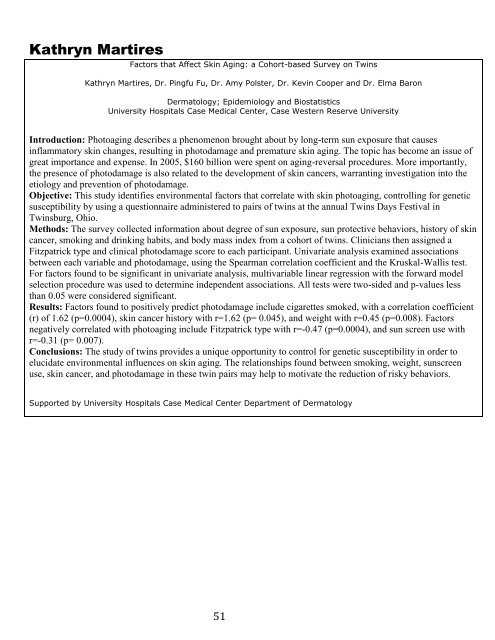student research day - Case Western Reserve University School of ...
student research day - Case Western Reserve University School of ...
student research day - Case Western Reserve University School of ...
Create successful ePaper yourself
Turn your PDF publications into a flip-book with our unique Google optimized e-Paper software.
Kathryn Martires<br />
Factors that Affect Skin Aging: a Cohort-based Survey on Twins<br />
Kathryn Martires, Dr. Pingfu Fu, Dr. Amy Polster, Dr. Kevin Cooper and Dr. Elma Baron<br />
Dermatology; Epidemiology and Biostatistics<br />
<strong>University</strong> Hospitals <strong>Case</strong> Medical Center, <strong>Case</strong> <strong>Western</strong> <strong>Reserve</strong> <strong>University</strong><br />
Introduction: Photoaging describes a phenomenon brought about by long-term sun exposure that causes<br />
inflammatory skin changes, resulting in photodamage and premature skin aging. The topic has become an issue <strong>of</strong><br />
great importance and expense. In 2005, $160 billion were spent on aging-reversal procedures. More importantly,<br />
the presence <strong>of</strong> photodamage is also related to the development <strong>of</strong> skin cancers, warranting investigation into the<br />
etiology and prevention <strong>of</strong> photodamage.<br />
Objective: This study identifies environmental factors that correlate with skin photoaging, controlling for genetic<br />
susceptibility by using a questionnaire administered to pairs <strong>of</strong> twins at the annual Twins Days Festival in<br />
Twinsburg, Ohio.<br />
Methods: The survey collected information about degree <strong>of</strong> sun exposure, sun protective behaviors, history <strong>of</strong> skin<br />
cancer, smoking and drinking habits, and body mass index from a cohort <strong>of</strong> twins. Clinicians then assigned a<br />
Fitzpatrick type and clinical photodamage score to each participant. Univariate analysis examined associations<br />
between each variable and photodamage, using the Spearman correlation coefficient and the Kruskal-Wallis test.<br />
For factors found to be significant in univariate analysis, multivariable linear regression with the forward model<br />
selection procedure was used to determine independent associations. All tests were two-sided and p-values less<br />
than 0.05 were considered significant.<br />
Results: Factors found to positively predict photodamage include cigarettes smoked, with a correlation coefficient<br />
(r) <strong>of</strong> 1.62 (p=0.0004), skin cancer history with r=1.62 (p= 0.045), and weight with r=0.45 (p=0.008). Factors<br />
negatively correlated with photoaging include Fitzpatrick type with r=-0.47 (p=0.0004), and sun screen use with<br />
r=-0.31 (p= 0.007).<br />
Conclusions: The study <strong>of</strong> twins provides a unique opportunity to control for genetic susceptibility in order to<br />
elucidate environmental influences on skin aging. The relationships found between smoking, weight, sunscreen<br />
use, skin cancer, and photodamage in these twin pairs may help to motivate the reduction <strong>of</strong> risky behaviors.<br />
Supported by <strong>University</strong> Hospitals <strong>Case</strong> Medical Center Department <strong>of</strong> Dermatology<br />
51
















